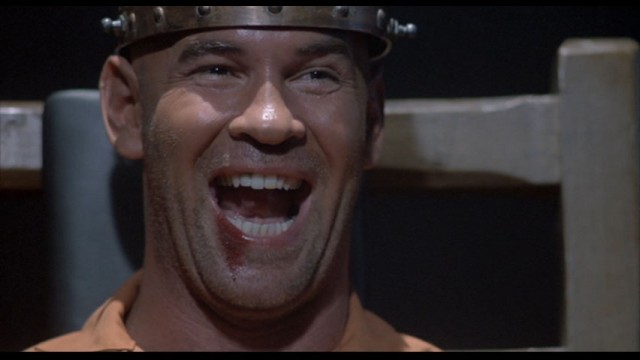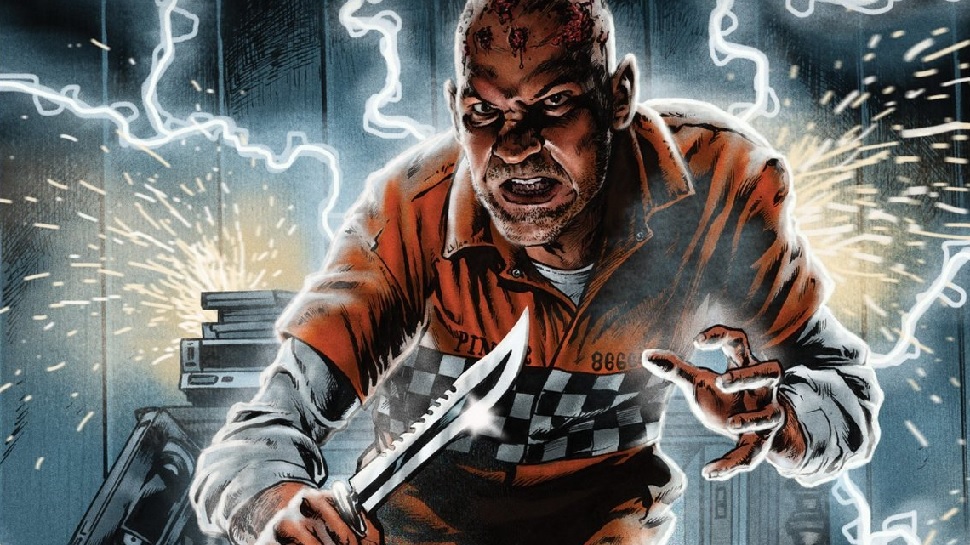Wes Craven’s 1989 film Shocker had a great concept, at least on paper. The idea of a mass murderer sentenced to death in the electric chair, only to come back stronger than before, is completely original and has loads of promise. There are any number of ways Craven could have woven this story to make for a compelling and scary movie. But he didn’t.
Shocker starts very abruptly by letting the audience know of serial killer Horace Pinker (Mitch Pileggi), a TV mechanic who revels in killing whole families in their living rooms. His exact number of kills is not made clear, but at one point it’s said that Pinker has killed 30 people. We know nothing of Pinker or his background except that he is “intelligent” and that the police have been unable to find him for nine months. The intelligent killer also makes a habit of parking his dirty repair truck in front of his victims’ homes, conveniently labeled with the name of his TV repair company “Pinker TV Repair”.
We are also immediately introduced to Jonathan Parker (Peter Berg), an all-American football player type with lots of friends and a pretty blonde girlfriend (Camille Cooper). In the opening scene Jonathan gets hit in the head a half dozen times during football practice and develops a concussion. Somehow the concussion enables him to see the future before it happens, particularly Pinker’s murders. Jonathan envisions Pinker killing his foster mother and foster siblings in a very vivid dream before waking up next to his girlfriend. As if on cue Jonathan’s foster father Lt. Don Parker (Michael Murphy) calls Jonathan to relay the news that they really were killed by Pinker.
Jonathan is able to convince Lt. Parker that his dream may have been real, and the police show up at Pinker’s rattrap TV repair shop to confront him. Pinker easily kills three police officers and then escapes in his dirty van. Jonathan identifies Pinker’s appearance to the press from his dream memories, so Pinker returns after escaping to kill Jonathan’s girlfriend, I guess just for fun. Jonathan has another dream indicating Pinker’s whereabouts and Pinker is finally apprehended.
It turns out that Pinker is a satanic animal abuser, something like the character of Charles Lee Ray in Child’s Play, who has an abnormal fascination with electricity (apparently due to his profession). Before being executed, in the most spontaneous death penalty conviction in U.S. history, Pinker electrocutes himself with his prison cell TV in a satanic ritual. After being revived he gives a very threatening and foul-mouthed speech before being strapped to the electric chair, at which point he indicates that he is in fact Jonathan’s real father. What?? This ends the first section of the movie, which wasn’t particularly good, but it is all downhill from here.
Horace Pinker appears to be dead but instead transfers his soul (via electricity) into the body of a female doctor who was present for the execution. For what seems like another hour Pinker keeps transferring his soul into other people, including a cop, a passing jogger, a burly construction worker, a little girl, the little girl’s mother, Jonathan’s football coach, and various others. Meanwhile Jonathan keeps having visions of his dead girlfriend and learns that a dime-store heart necklace he gave her is some sort of talisman that can defeat Pinker. No reason is given for this, although at one point she gives a prayer for Jonathan’s safety and she is presumably a Christian.
Pinker eventually invades the body of Lt. Don Parker in a climactic standoff on top of some TV tower or similar. Just when the film seems to mercifully come to a natural end it seems Pinker’s soul becomes even more electricity-based and Pinker suddenly has the ability to travel seamlessly through any electrical outlet–through TV’s, through microwaves, etc. Jonathan is able to do the same, thanks to the heart-shaped necklace that his dead Christian girlfriend gave him. This leads to an embarrassing sequence of Pinker and Jonathan fighting each other within the context of various TV shows, within a TV set. For example, they will briefly appear in a vintage World War II movie and the soldiers in the movie will comment something like, “Who the hell’s that guy?” Yes, the actors in a movie that is being shown on TV. If that sounds stupid, you have no idea how bad it actually looks.
Finally, Pinker is put to rest when Jonathan’s football buddies disable the entire city’s power supply while Pinker is trapped within the television set, or within some kind of electrical purgatory (it’s not entirely clear). And the viewer is speechless, because, well, the movie started off okay and ended up completely and utterly ridiculous. I cannot think of another movie offhand that gets progressively worse from start to finish on a gradual curve. It reminds me of the scene in Office Space when main character Peter Gibbons (Ron Livingston) visits a psychiatrist and states that every new day is the worst day of his life. Every second of Shocker is worse than the second before it, until the very end when the title credits roll and the film very suddenly improves.
One of the few bright spots of Shocker is the character of Horace Pinker as portrayed by Mitch Pileggi. Astute viewers will most certainly recognize Pileggi from his role as FBI Assistant Director Walter Skinner from the X-Files TV show and movies. Pileggi portrays Pinker as a sadistic cold-blooded killer, someone who absolutely deserved the death penalty, in case there were any doubts. Pinker’s death penalty speech is classic — Pinker is a rabid animal that everyone in the room can’t wait to get rid of. He has murdered whole families, he killed at least three police officers, and he does not have the least bit of remorse. Pinker also can’t complete a single sentence without an expletive, and he’s full of amusing one-liners like “C’mon, Boy, let’s take a ride in my Volts Wagon” and “It’s hard to outrun a (running?) kilowatt, asshole”. Shocker also has a very curious appearance by LSD guru Timothy Leary as a televangelist. Finally, horror fans may be mildly interested in the supporting acting role of Ted Raimi, brother to Sam Raimi (Evil Dead, Army of Darkness,Spiderman).
The other main draw of Shocker is its driving thrash metal soundtrack, which is fun and heavy and one of the few incentives to sit through the entire movie. Compiled by song doctor Desmond Child, the soundtrack features contributions from Megadeth, Alice Cooper and a number of other metal artists of the time. The film also features the only appearance by “supergroup” The Dudes of Wrath. The band was formed specially for the movie and featured Paul Stanley (Kiss) and Desmond Child on vocals, Vivian Campbell (Def Leppard) and Guy Mann-Dude on guitars, Rudy Sarzo (Whitesnake) on bass guitar, and Tommy Lee (Mötley Crüe) on drums. Also backing vocals by Michael Anthony (Van Halen) and Kane Roberts (Alice Cooper). The Megadeth contribution is the previously unreleased cover of Alice Cooper’s “No More Mr. Nice Guy”.
For other horror-related articles, please see:
- Chucky: The Killer DVD Collection (review)
- EMP Museum succeeds with Can’t Look Away: The Lure of Horror Film
- Final Destination 5 meets expectations
- George Romero’s ‘Survival of the Dead’ – dead on arrival
- Hellraiser: Revelations deserves another look
- Hostel: Part III a missed opportunity
- Leprechaun – Decades later and still not scary
- ‘Mega Piranha’ – so bad it’s good?
- Review of ‘Memory’ from 2006, starring Billy Zane
- Review – Zombie Diaries 2, aka World of the Dead: The Zombie Diaries
- Seattle’s ZomBcon raised the living dead
- Seattle’s 2012 MIFFF opens with Mon Ami
- Tobe Hooper ‘Mortuary’ – brain-dead zombies and black fungus
- Wes Craven ‘Cursed’ falls short of potential
- 2002 film ‘They’ explores night terrors
ErikTomrenWrites is a participant in the Amazon Services LLC Associates Program, an affiliate advertising program. Your purchases on Amazon.com via our links will help support ErikTomrenWrites – at no extra cost to you!





Pingback: 'Mega Piranha' - so bad it's good? - #ErikTomrenWrites
Pingback: Hostel: Part III a missed opportunity - #ErikTomrenWrites